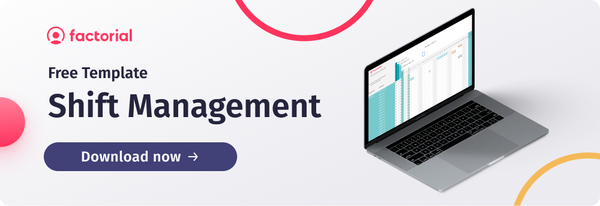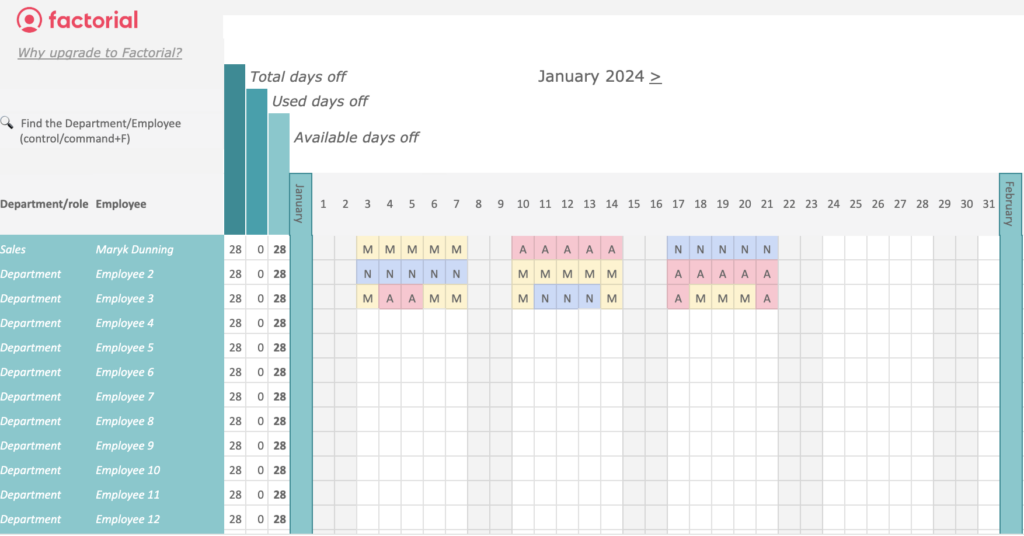Planning and implementing a good office rota is challenging. Doing so whilst taking work rota laws into account is even more so. But having a reliable and structured shift management system is useful for both large and small businesses, whether they are operating across many employees or a handful.
It’s crucial to the long-term health of your business that you not only ensure it operates profitably but also that you pay attention to maintaining a productive, healthy workplace.
In this guide, we will start with an overview of how a work rota works, then look at the legal obligations you must meet regarding staff rota scheduling. We’ll also provide tips for creating the best shift rota pattern for your company.
Work Rota Laws in the UK
The Working Time Regulations 1998 (WTR) apply to employees in all sectors across the UK and stipulate that:
- Employees should not work more than an average of 48 hours each week. However, individuals have the right to opt out of this agreement if they wish to work more, provided they give their employer written notice and are over 18 years old.
- Employees should be given 11 consecutive hours off between shifts, and one day off every seven days must be given, or compensation is due.
The Health and Safety at Work Act 1974 also states that employers are required by law to:
- Provide ‘suitable’ rest facilities for employees working through their breaks.
- Provide your employees with a work rota with advance notice. “Advance” is a legal term meaning there is no minimum or maximum amount of time they have to be given their shift schedules. Therefore, you should notify your employees at least one week to help them properly prepare for work.
- Keep full records of hours worked by their staff and ensure these are accurate. You can do this with our shift management software.
Common Questions About Work Rota and the UK Law
Can My Employer Force Me to Change My Shift?
This depends on what is written in your employment contract. If your contract sets fixed hours and working patterns, then your employer cannot force you to change your shift. However, an employer can change your working hours, including shift patterns, as long as the contract allows. If an employee signed up for a more flexible contract, an employer can change their contraced working hours.
If this is the case, it’s worth voicing your concerns to allow your employer to work out a compromise. However, the employer can refuse to do so and force you to accept their request.
Forcing employees into working patterns they are not comfortable with can damage morale and an employer’s brand reputation. Finding a happy medium that works for both parties is advisable.
How Much Notice Does an Employer Have to Give for a Shift Change in the UK?
There is no rule on how far in advance rotas should be done or shift change notice should be given. The law simply says employers must provide employees with a work rota in “advance”. “Advance” is a legal term meaning there is no minimum or maximum amount of time they have to be given their shift schedules. However, it is best to work out the schedule at least a week before the first shift is due to start. This gives your employees enough time to organise their lives around the rota and plan ahead.
How far in advance they should be noticed will depend on what is stated in their contract or employment policy. If your contract states a specific shift change notice period, they are legally obliged to follow this.
Changing rotas without notice can dangerously affect your employees’ health, wellbeing, and productivity. The same can be said for cancelling a shift last minute. Essentially, the more notice, the better.
If you are unsure whether your employees can cover specific shifts, you should ensure you have an effective communication system in place so they can contact you and let you know if they’re available on certain days. You should also have clear guidelines on what happens when an employee calls in sick or wants to book time off.
Can My Employer Change My Shifts Without Asking?
In short, yes. Employers don’t need permission to change shifts if flexibility is written into the employment contracts. However, they must follow the correct procedure in doing so.

How Long Can an Employer Keep You After Your Shift UK?
Your employer has no legal right to force you to work longer than your contracted hours. They can ask, and you can accept, but there is no obligation to. Read up on overtime laws and pay to know your rights in this area.
Is a Rota a Legal Document?
Yes. Although there is no specific law against not publishing work rotas, they are considered an essential part of planning work duties and allocating staff accordingly.
The Working Time Regulations 1998 state that all employees have the right to know their working schedules in advance, including any additional hours required to work. The same goes for any changes that may occur during the rota period. If you are managing a team, ensuring that this is carried out effectively will fall upon you.
Night Work Shift Limits and Laws
By law, if your staff works at least 3 hours in a night shift (11 pm to 6 am), they are considered a night worker. Shifts within this window would also be considered unsociable hours. They will probably be entitled to Minimum Wage, but you’re not obligated to pay higher rates for night shifts.
Moreover, young workers between 16 and 17 cannot work longer than 10 pm, so they won’t be entitled to night shifts.
For workers who can sleep between tasks, the minimum wage will only be paid for the hours the employee was awake.
On the other hand, you need to be aware of the working hours limit that affects night workers as night working hours work slightly differently in the UK. Night workers are not legally allowed to work an average of 8 hours in a 24-hour period. This includes regular overtime (not occasional overtime) and should be calculated over a 17-week period. This can be extended to 52 weeks if the employee and employer agree. Night shift staff have no option to opt out of this limit.
As an employer, you must keep records of the past two years to ensure your staff are not exceeding the working hours limit.
Rest Breaks
There are three types of work breaks you must provide to your employees.
- Rest breaks at work daily and a weekly rest break.
- Employees who work in 6 hour-shifts or longer are entitled to a 20-minute rest break at the workplace.
- Employees have the right to at least 11 hours of rest between working days. Employees must have an uninterrupted 24 hours without any work each week or an uninterrupted 48 hours without any work each fortnight.

Managing Risks Associated with Shift Work
Working shifts can be a positive experience for both you and your employees, but you need to be aware of the risks associated with shift work.
The Health and Safety Executive (HSE) has identified the following fundamental issues:
Fatigue and Tiredness
Workers are more likely to report fatigue if they must work long hours. This will lead to a decline in the quality of work and potentially increase the risk of accidents. You should have rules in place that ensure workers remain alert while at work.
You may also want to consider assisting employees with childcare or transport if their contracted working hours make it difficult for them to attend school or childcare facilities.
Sleep Disturbance
Sleep disturbance is one of the main problems with shift work. People who do shift work often struggle to sleep during the day, which can mean they are affected by sleep debt. This condition occurs when people do not get enough quality sleep regularly. Sleep debt can result in fatigue, irritability, poor concentration, and reduced alertness, leading to work errors.
You must provide your staff with a rota that details their shifts well in advance — the best would be at least four weeks before the schedule begins. It is also good practice to display them in a prominent place so employees know what shifts they’ll be working and can plan.
Lack of Communication Between Shifts
Communication is key when dealing with shift work. It is important for all workers, regardless of which shift they are on, to know what other teams are doing and how their tasks relate to those being done by others. This lack of communication can lead to increased workplace stress and safety issues if not addressed. Communicate with your workforce using employee apps like Beekeeper.
Social Isolation
Workers may find themselves having to turn down social events, or they cannot spend as much time as they’d like with their friends and family.
This type of lifestyle can lead to long-lasting stress, depression, and other mental health issues, so HR managers must consider social consequences to build an effective rota.
Free Shift Rota Planner
You can easily use a staff rota template to organise employee shifts. Our free work rota template is available to download below.
Excel timesheets can help you kickstart your rota system, but it can get tricky to calculate pay rates and ensure your employees are not working above the working hour limit. An all-in-one shift management tool and attendance tracking software would be a better solution. It will allow you to easily track your employees’ rotation hours and provide shift templates to simplify the process.
As your company grows, keeping a record of your staff’s working hours becomes tricky. But it is essential to ensure workplace sustainability and workers’ legal rights. That’s why HRIS are essential tools to manage work rota. As a plus, setting the right system will help you easily recognise workflow patterns that are not performing well and measure productivity.
Working Time Regulations and Shift Work Patterns
UK employment law (Working Time Regulations) states that:
- An employee cannot work more than 48 hours per week on average, including overtime working hours. It is important to note that average is calculated over 17 weeks and can be extended up to 26 weeks with a collective agreement. This means that you can put an employee on a 12-hour day shift and make it last longer than 48 hours if they get compensated rest days or extra paid vacation days later.
- A shift pattern must include 11 consecutive hours of rest breaks. And 24-hour rest should be provided in any period of 24 hours worked by an employee.
- A day off should be given at least once every two weeks (actual work time must not exceed 6 days). If necessary, this can be reduced to once every three weeks with a collective agreement, but no longer than this.
The best way to comply with these regulations is by using a planner tool that automatically calculates breaks and ensures there are no violations in the final schedule.
The following is a list of the most common shift models you can adopt for your company:
- Alternate: Shift workers show up for work in alternating shifts. There are two alternating shifts, and the start times between each shift are close together or even overlapping. This shift pattern is commonly used in businesses where the workload is consistent throughout the day or night.
- Continuous: This extended fixed-shift schedule has 24/7 operations and requires employees to work 12-hour shifts for three days at a time. This shift pattern offers employees more time off, but it also means they have to work longer.
- Double: Three teams work in two consecutive shifts in this shift pattern. They alternate between working in the morning and afternoon, allowing each team to have one full day off after every other working day to rest before the next shift starts.
- Triple: Three teams rotate their shifts over 24 hours so that someone is always available at any time of day or night to keep operations running smoothly. This kind of shift pattern is often used in manufacturing plants.

Features of a Successful Shift Management Strategy
Successful shift management plans will have many features that showcase whether it’s a winning strategy. But there are a handful of key features that, if present, make it far more likely for employee scheduling to be a successful endeavour.
Here are some crucial features you’d want your employee scheduling strategy to include.
Predictive Scheduling
This feature uses historical data and demand forecasting to create schedules that optimise labour costs while ensuring adequate staffing. It minimises under or overstaffing by aligning employee work hours with the actual workload, resulting in cost savings and improved operational efficiency.
Accurate Time and Attendance Tracking
Accurate time tracking is a cornerstone feature. It involves reliable clock-in and clock-out mechanisms, often facilitated by time-tracking software or hardware. This ensures that employees are paid correctly for their hours worked and helps prevent time theft.
Streamlined Shift Swap and Coverage
Who doesn’t like having a system for employees to swap shifts or request coverage easily? It simplifies accommodating employee preferences, allowing teams to adapt to unforeseen changes without disruptions. This feature enhances employee satisfaction and minimises scheduling conflicts.
Real-Time Visibility
Providing real-time insights into shift and employee performance is a crucial feature. Managers can monitor ongoing operations, track employee attendance, and make immediate adjustments. This real-time visibility enhances decision-making, improves efficiency, and helps address issues promptly, leading to a more agile and effective workforce management system.
Types of Shift Rotation
There are several types of shift rotation systems organisations operate under, each with its own advantages and disadvantages. Regardless, the choice of shift rotation depends on various factors, including the nature of the work, employee preferences, operational requirements, and legal regulations. Here are a few types of shift rotation schedules that work effectively.
1) Dupont Shift Schedule
The Dupont shift schedule involves four teams of employees rotating two 12-hour shifts over a four-week cycle. This means:
- Working four-night shifts, followed by three days off
- Three-day shifts, one day off
- Three-night shifts, three days off
- Four-day shifts, seven days off
While the Dupont schedule allows for a full week of rest, the long shifts and limited days off in between can be challenging for some, especially considering the occasional need to work more than 40 hours in a week.
2) Southern Swing Schedule
The Southern swing schedule operates on a 28-day cycle, using three eight-hour shifts. Four teams rotate between seven-day shifts, followed by two days off, then seven swing shifts, two days off, seven-night shifts, and finally, three days off. This schedule provides the advantage of shorter eight-hour shifts, but the consecutive seven-day work period may require some adjustment.
3) Pitman Shift Schedule
The Pitman shift schedule, known as a 2-3-2 schedule, follows a two-week cycle. Employees work two shifts, followed by two days off. Then they work three shifts, followed by two days off. This is followed by two shifts and three days off, creating a pattern that repeats every two weeks. Each shift lasts 12 hours and can be during the day or night, but allows employees to enjoy every other weekend off, providing a sense of normalcy and ample time for family or personal tasks.
4) 2-2-3-2-2-3 Shift Schedule
The 2-2-3-2-2-3 shift schedule operates on a 28-day cycle and involves 12-hour rotating shifts. It’s got an extensive variation of shift scheduling, and consists of:
- Three consecutive day shifts, followed by two days off.
- Two day shifts, followed by three days off.
- Two night shifts, followed by two days off.
- Three consecutive night shifts, two days off, two night shifts, and three days off.
- The cycle ends with two day shifts and two days off.
This schedule offers frequent days off, with no more than three consecutive work days, and provides employees a three-day weekend every other week. However, it’s important to note that 12-hour shifts can be demanding, especially in physically intensive industries like construction or healthcare.
Shift Management with Factorial
Factorial’s shift scheduling software revolutionises your shift management needs, offering an all-in-one solution to effortlessly create and optimise work schedules. With user-friendly scheduling tools, you can schedule shifts to match your operational demands and employee availability. Factorial also simplifies shift tracking, enabling you to monitor attendance and manage any changes, and with its shift management tool, you can easily delete, modify, and compare shifts, all while customising the view to streamline your employee shift schedules.
Shift Management FAQs
What is Shift Management?
At first glance, you might think shift management simply involves creating a work schedule in which the right team members are available for the right tasks at the right times. However, it’s much more than that. The entire process from start to finish is dynamic and strategic, nowadays likely requiring efficient scheduling software to really nail the ins and outs because you need to consider employee availability, handle scheduling conflicts, and maintain seamless team communication. But with the right tools, you can easily track time, create schedules, and even manage open shifts with ease.
With that said, as a shift manager, you’re ultimately aiming to optimise the way your company shifts are going, guaranteeing coverage, adapting when needed, and all the while making life easier for yourself and your employees.
What is Shift Scheduling?
At its core, shift scheduling involves the meticulous planning of work shifts, making sure that all necessary tasks are covered and that employees are assigned to changes that match their skills and availability. Think of it as a facet of shift management.
A pitch-perfect approach to shift scheduling can help you streamline operations, enhance team communication, and provide a clear framework for everyone to follow, scheduling employees with precision and keeping everyone happy, committed, and engaged.
What is Shift Rotation?
Shift rotation refers to the practice of systematically rotating employees through different work shifts or schedules within a business or organisation. It’s a strategic approach aimed at maintaining productivity, optimising operational efficiency, and ensuring smooth transitions between shifts, allowing organisations to distribute workload accurately while maintaining a consistent level of service or production.
But why is shift rotation important? Well, imagine a scenario where an organisation’s work rota operates 24/7 or has extended business hours, such as manufacturing, healthcare, transportation, or customer service. Without an effective shift rotation plan, the transition from one shift to another can be chaotic, leading to many challenges that can negatively impact productivity and employee well-being.







